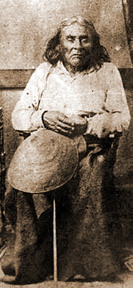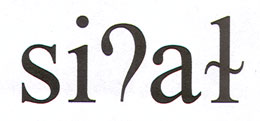Although we call him “Chief” Seattle, there were no hereditary chiefs
among the Puget Sound Indians. Strong leaders arose in each village from
time to time who, distinguishing themselves by the actions or particular
skills, were respected and followed. For instance, there were fishing
leaders, peacetime leaders, and leaders in times of crisis. Chief Seattle
was one of those. In addition to his leadership skills and his ability to
understand what the white settler's intentions were, he was also a noted
orator in his native language. At the presentation of the treaty proposals
in 1854, Chief Seattle delivered a magnificent speech, which is widely
remembered today. It is the speech of a man who has seen his world turned
upside down in his own lifetime: as a boy, he had seen Vancouver’s ships,
and when he died the treaty protests were still going on....From his grave on
the Kitsap Peninsula the modern city of Seattle is visible across Puget
Sound. Knowing some of the settlers as well as he did, the fact that the
small village bearing his name survived and flourished would not surprise
him. That his people have survived the challenges of this century would
please him.
Chief Seattle’s father, Schweabe, was a Suquamish chief from
Bainbridge Island, across Puget Sound from the
present city of Seattle. But Chief Seattle was considered a member of the
Duwamish tribe, who lived on a river in southwest Seattle, across Puget
Sound from the present-day reservation of the Suquamish tribe on the Kitsap
Peninsula. His mother, Scholitza, was the daughter of a
Duwamish chief, and the line of descent among the Duwamish traditionally
runs through the mother.
Early Seattle historian Clarence
Bagley wrote that Chief Seattle as a young warrior was known for his courage,
daring, and leadership in battle. He gained control of six local tribes and
continued the friendly relations with local Europeans that his father began.
Chief Seattle gave a famous
speech in December 1854 in what is now downtown Seattle, when he was in his late
fifties or early sixties. The only known version of it comes from the pen of
Dr. Henry A. Smith, a settler and amateur poet who was present and detailed
notes at the time. But Smith didn’t speak Lushootseed, the language in which
Chief Seattle gave the speech, and he waited 30 years before he transcribed
his notes about the speech. Smith’s “Chief Seattle” speech, as he rendered
it from his notes, contains 19th-century rhetorical flourishes that make it
sound like he invented some of it. (Smith admitted in his introduction to
the speech that his version of it was “a fragment of [Chief Seattle’s]
speech, and lacks all the charm lent by the grace and earnestness of the
sable old orator, and the occasion.”
Chief Seattle has had a worldwide influence in another way.
His daughter, called “Princess Angeline” by local
European-Americans, lived out her old age in a waterfront shack in
present-day downtown
Seattle. A young photographer, Edward S.
Curtis, who often saw her in Seattle, became
intrigued by her and often photographed her and talked with her. Curtis’s
interest in Princess Angeline led to an interest in other American Indians,
and Curtis went on to become the most famous photographer of them. He
devoted most of his life to taking pictures of Indians all over
America, with the financial backing of industrialist/art collector J. P.
Morgan and the encouragement of President Theodore Roosevelt. His monumental
work in documenting the lives of the first Americans ranks him among the
greatest photographers of all time.
Chief Seattle as a young boy probably saw the first
Europeans who
visited the Puget Sound region area: Captain George Vancouver and
his sailors, when they anchored their ships the Discovery and the
Chatham near the southeast corner of Bainbridge Island, across from the
present-day city of Seattle, in 1792. Chief Seattle was always intrigued by Europeans
and their culture, and he later became good friends with Doc Maynard, the
adventurous, hard-drinking entrepreneur who more than anyone helped
establish the city of Seattle. Chief Seattle saved Doc Maynard from
an assassination attempt by another Indian. Chief Seattle also helped
protect the small band of European-American settlers in what is now Seattle
from attacks by other Indians. Because of his friendship and help, at the
urging of Doc Maynard, the settlers named their city after him.
|

 Noah Seattle
Noah Seattle

